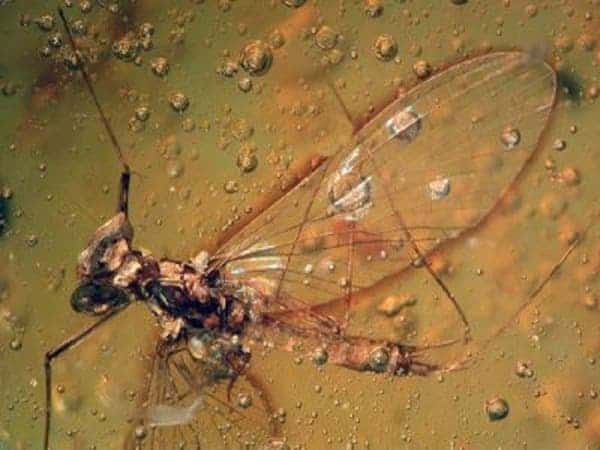
(Photo : Dr. Dave Penney/The University of Manchester) A springtail can be seen resting on this adult mayfly’s back.
We may associate hitchhiking with older times, but 16 million years ago? That sounds like a far way back. Researchers from the University of Manchester have found evidence of springtail hiking on the wings of mayflies; using an incredible composition of scans that resulted in a 3D image, scientists have actually caught them in the act.
The hitchhiker’s guide to the Miocene
“I had initially thought the creature on the mayfly may have been a tiny nymphal pseudoscorpion, as they are known to use other creatures for transport, and this behaviour is not uncommon to see in amber. I was interested in the fact that this was the first time a creature had been found on an adult mayfly but I didn’t truly appreciate the significance of my find until I used the CT scanner and was able to identify the animal as a springtail,” said lead author of the study Dr. David Penney from the Faculty of Life Sciences and the School of Materials at the University of Manchester.
As a sidenote, the Miocene is a geological epoch of the Neogene Period extending from about 23 to 5.3 million years. During this period, plants and insects were relatively modern.
The springtail was hooked to the mayfly using antennae designed specifically for grabing, latching on to the depression at the base of one of the mayfly’s wings. However, although you can’t really see this with the naked eye, there is a small, 5 micron, distance between them, suggesting that the two might have been caught in amber just as the springtail was preparing to jump.
Phoresy – biology’s hitchhiking
The two creatures trapped in ambera could prove to be very useful in terms of understanding those days. Phoresy, the transportation of one organism by another usually tells you a lot about creatures’ behaviour and, of course, researchers hope to understand more by analyzing this situation, especially considering the nature of the two insects. Mayflies don’t even eat (they don’t even have mouth parts), having a lifespan of a few minutes up to a few days. Meanwhile, the springtail is your typical nervous, jumpy insect-like creature. which is extremely hard to study. The technique is also extremely important.
“The CT scan allows us to build up a 3D image that catches minute details of the animal. We can rotate the image to see parts of the creature that are obscured when looking from the outside in. In effect, we are able to digitally dissect the fossil without causing any damage to it whatsoever. This technology has revolutionized how we study fossils and the findings are incredibly exciting,” says Mr. Penney.
Source: University of Manchester









